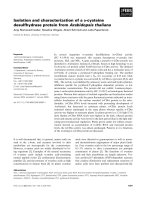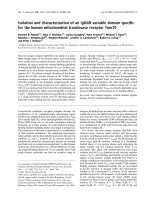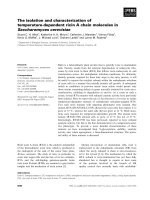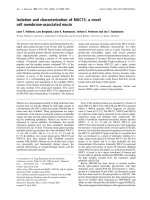Isolation and characterization of bacterial pathogen causing soft rot disease of potato tubers
Bạn đang xem bản rút gọn của tài liệu. Xem và tải ngay bản đầy đủ của tài liệu tại đây (559.47 KB, 8 trang )
Int.J.Curr.Microbiol.App.Sci (2018) 7(7): 2627-2634
International Journal of Current Microbiology and Applied Sciences
ISSN: 2319-7706 Volume 7 Number 07 (2018)
Journal homepage:
Original Research Article
/>
Isolation and Characterization of Bacterial Pathogen Causing
Soft Rot Disease of Potato Tubers
G. Biswal* and N.K. Dhal
Department of Plant Pathology, College of Agriculture OUAT, Bhubaneswar-3, India
*Corresponding author
ABSTRACT
Keywords
Bacterial pathogen,
Soft rot disease,
Potato tubers
Article Info
Accepted:
20 June 2018
Available Online:
10 July 2018
The rotting of potato tubers is usually noticed from the time of planting till harvesting also
in country stores as well as in cold stores. The proper isolation, pathogenicity testing and
necessary characterization studies are very much essential for identification of actual
causal organism which is very necessary for development of effective management
strategy. In this context systematic studies were conducted in Department of Plant
Pathology, College of Agriculture, Orissa University of Agriculture and Technology for
isolation and characterization of bacterial pathogens causing soft rot of potato tubers which
were collected from experimental plots of potato Research Project, Central Farm, OUAT,
Bhubaneswar. From the rotted tissues the bacteria was isolated aseptically and
pathogenicity was proved. Microscopic studies revealed the isolate was gram negative rod,
non-capsulated with peritrichous flagella. Colonies on Nutrient Sucrose Agar medium
were raised, convex, shining, white fluidal and slimy while grown on endo agar they found
to be circular with initially pink coloured but later turning to deep red. The colonies on
Tetrazolium Chloride medium were cream coloured. On Crystal Violet Pectate medium
the bacterial masses produced deep cup shaped cavities on the petriplates. Biochemically,
the response of isolates to ONPG, orinthrine and lysine was studied. Response for
deamination, nitrate reduction, H2S production, citrate reduction recorded. Methyl red test
was found to be positive while indole, melonate and esculin tests as negative. The isolate
could ferment carbohydrates such as adonitol, rhamanose, trehalose, glucose, lactose while
xylose, cellobiose, meliobiose, saccarose, raffinose not fermented. Furthermore, the
isolates could express the presence of oxidase, not hydrolysed gelatine and starch. From all
these studies it was confirmed that the causal organism was Pectobacterium carotovorum.
Introduction
The rotting of potato tubers is usually noticed
from the time of planting till harvesting also in
country stores as well as in cold stores. The
rotten tubers may be of brown rot, soft rot,
mixed brown rot and soft rot and other types.
The proper isolation, pathogenicity testing and
necessary characterization studies are very
much essential for identification of actual
causal organism which is very necessary for
development of effective management
strategy. In this context systematic methods
were followed in Department of Plant
Pathology, College of Agriculture, Orissa
University of Agriculture and Technology for
2627
Int.J.Curr.Microbiol.App.Sci (2018) 7(7): 2627-2634
isolation and characterization of bacterial
pathogens causing soft rot of potato tubers
which had already been followed in Japan,
Mauritius, Iran and Bangladesh (Rodney et
al., 2010; Harita et al., 2010; Suga et al.,
2013; Ravari et al., 2011; Rahman et al.,
2012).
extend of rotting were recorded after the
period of incubation. The most virulent strains
were selected for further studies.
Morphological characterization of bacterial
isolates
Gram staining for cell wall determinations
Materials and Methods
Potato tubers showing soft rot symptoms were
collected from experimental plots of Potato
Research Project O.U.A.T. in the year 2012.
Tubers were washed with sterilized water, air
dried and then surface sterilized with 70%
ethyl alcohol. Each tuber was examined by
cutting into two halves with the help of a
flame sterilized knife. From the rotted tissues
the bacteria was isolated aseptically and
pathogenicity was proved in healthy tubers
which developed symptoms similar to field
infection.
Pathogenicity test
The test bacterial isolate were subjected to
pathogenicity test to study their virulence and
subsequently exposed to a series of
biochemical tests for identification of bacterial
isolates. Ten numbers of apparently healthy
tubers were collected for each bacterial
isolate. The tubers were washed thoroughly
with distilled water followed by surface
disinfection with 70% ethyl alcohol. A small
deep bore was made up to the centre of each
potato tuber with the help of a 5 mm size cork
borer. Five such centrally hollow tubers were
used for each bacterial isolate and five tubers
were kept as control. 0.5 ml of bacterial
suspension (about 108 cfu/ml) was aseptically
transferred into each of the bore well and the
excised piece of the tuber was replaced to
close its mouth of the well. Each inoculated
tuber was kept in separate polythene packet
and incubated at 27± 10C for 7days. A set of
five tubers inoculated with sterilized water
served as control. Observations on type and
For the purpose of Gram staining of bacteria, a
thin smear of the bacterial suspension from a
24 hour old bacterial growth was made on a
clean glass slide and air dried. The bacteria
was heat fixed by running the under surface of
slide over a flame of a burner for two to three
times. Care was taken not to overheat bacterial
smear and allowed to cool to normal
temperature. The smear was then flooded with
Hucker’s Ammonium oxalate crystal violet
solution for one minutes, followed by gently
washing in running tap water until clean water
flowed from the slide. Excess water was drain
out. The smear was then flooded with Gram’s
modified Lugo’s Iodine solution for 1 minute
followed by washing and drying as described
earlier. Then the smear was held in a inclined
position and the decolourizer solution (95%
ethyl alcohol) was added drop by drop and
was allowed to flow over the smear for about
06 seconds. Immediately, the slide was
washed in running water. Finally, the smear
was counter stained with safranie solution for
30seconds followed by immediate washing the
slide in running water and blot dried. The
smear was examined under a microscope
using oil-immersion lens. Also, the shape and
size of the bacterial cells were recorded.
b) Studies on flagellar attachment
Tannic acid and ammonical silver nitrate
solutions were used for flagella staining. A
faintly cloudy bacterial suspension was made
by carefully transferring 1.0 ml of sterile
distilled water to the tuft of 24 hour slant. The
bacteria was allowed to migrate into the water
without any mechanical agitation to form a
2628
Int.J.Curr.Microbiol.App.Sci (2018) 7(7): 2627-2634
faintly cloud suspension. A loop full of
distilled water placed at the centre of clean
slide, A loop full of bacterial suspension was
placed on the slide by just touching the
distilled water and was allowed to air dry. The
bacterial film thus prepared was flooded with
tannic acid solution which was allowed to
stand 5 to 6 minutes and then rinsed with
distilled water.
Ammoniated silver nitrate solution was added
over the smear for few seconds. Finally the
slide was washed in running water and air
dried. The smear was then examined under a
microscope using oil immersion lens. The
bacteria and flagella were stained brown and
light brown respectively on a light to golden
back ground.
Cultural character of bacterial isolate
Growth on nutrient sucrose agar medium
Studies on colony morphology of each test
bacterial isolate were done separately by
growing them on NSA plates following streak
plate method. A loop of 24-48 hour old
bacterial culture was taken aseptically with the
help of inoculating needle and continuous
streaks were drawn on well dried surface of
NSA plates. The plates were incubated at
27±10C in a BOD incubator for 24-48 hours.
Observations on the shape, margin, elevation
and colour of the bacterial colony were
recorded.
development of cavities on CVP medium were
recorded. Formation of deep cup shaped
cavities indicated P. carotovorum.
Starch hydrolysis test
Bacteria have been characterized on the basis
of their ability to utilize complex insoluble
organic food in the same manner as that of
higher animals by secreting enzymes into the
surrounding medium. Firstly, nutrient agar
medium containing 1 % soluble starch was
prepared and sterilized.
The starch enriched medium was transferred
into sterilized petridishes. After solidification,
each bacterial isolate was inoculated
separately by drawing 2-3 streaks on the
medium surface and incubated at 27±1oC for
24 hours. Each petriplate with bacterial
growth was flooded with Iodine solution.
Formation of clear zone around the bacterial
growth indicated positive reaction to
hydrolysis of starch.
Gelatine liquifaction test
Bacteria have been differentiated on the basis
of their pectiolytic potentialities such as the
ability to liquefy gelatine. 5 to 7ml of nutrient
gelatine medium after preparation was
transferred into each tube sterilized and
cooled. The tubes were kept vertically. Two
tubes were simultaneously inoculated with
bacterial species.
Bio-chemical character of bacterial isolates
Pectiolytic ability test
Bacteria have been characterized on the basis
of their ability to degrade pectin in food.
Firstly, crystal violet pectate medium was
prepared, sterilized and transferred into
sterilized petridishes as described earlier.
After solidification, the bacterial isolate was
stab inoculated at four points on each plate
and incubated for 48 hours. Observations on
Two uninoculated tubes served as control. All
were incubated at 27±1oC.. Observations from
2nd to 7th day of incubation were taken. For the
purpose, the tubes were placed at 4oC for 30
minutes after each specific growth period.
Immediately after taking out from the low
temperature condition, each tube was held
parallel to the surface and gently tapped 3-4
times. Flowing of medium from the stub
indicated positive reaction. The medium
2629
Int.J.Curr.Microbiol.App.Sci (2018) 7(7): 2627-2634
which flowed down after the 2nd day of
incubation recorded as fast liquification, 3rd
and 4th day after incubation recorded as
moderate liquification ability and no flowing
of medium within 5-7th day of inoculation
indicated slow reaction. Each tube was
compared with uninoculated control where the
medium did not flow down even after tapping
for 3-4times indicating negative result.
Results and Discussion
Microscopic studies revealed that the isolate
was gram negative rod, non-capsulated with
peritrichous flagella. Colonies on Nutrient
Sucrose Agar medium were raised ,convex,
shining, white fluidal and slimy. Colonies on
endo agar were found to be circular with
initially pink coloured but later turning to deep
red.
Oxidase test
Small quantity of 24 hours bacterial growth of
each test bacterium was picked up with the
help of platinum loop of an inoculation needle
and was placed on commercially available
oxidase discs (Hi-Media). Development of
purple colour within 10 seconds was rated as
oxidase positive. Colouration developing
between 10-60 seconds rated as delayed
positive and where no colour developed even
after 60 seconds was rated as oxidase
negative.
e) Other biochemical tests
Biochemical tests like citrate utilization, lysine
decarboxylation, ornithine decarboxylation,
urease detection, phenylalanine deamination,
H2S production, nitrate reduction, Voges
Proskaur (VP), Berrits, Methyl red, Indole,
Malonate and Esculin tests were done by
using ‘Hi Media’ test kits.
Carbohydrate utilization test
The test bacterial isolates were characterized
by the ability of the test bacterial species to
utilize specific carbohydrates. Twelve
carbohydrates such as; glucose, lactose,
arabinose,
adonitol,
sorbitol,
xylose,
rhamnose, cellobiose, mellbiose, saccharose,
raffinose, trehalose and esculin were tested
using ‘Hi Media Test Kit’. Separate test kits
were used for each test bacterial isolate
The colonies on Tetrazolium Chloride
Medium were cream coloured. On Crystal
Violet Pectate medium the bacterial masses
produced deep cup shaped cavities on the
petriplates (Table 1).
Biochemically, the isolates showed negative
response to ONPG, failed to decarboxylase
orinthrine and lysine.
The presence of urease was not observed.
Deamination,
nitrate
reduction,
H 2S
production, citrate reduction could not be
expressed. Methyl red test was found to be
positive while indole, melonate and esculin
tests as negative (Table 2). The isolate could
ferment carbohydrates such as adonitol,
rhamanose, trehalose, glucose, lactose while
xylose, cellobiose, meliobiose, saccarose,
raffinose not fermented (Table 3).
Furthermore, the isolates could express the
presence of oxidase, not hydrolysed gelatine
and starch. From all these studies it was
confirmed that the causal organism was
Pectobacterium
carotovorum.
BagheeRavleari et al., (2011) worked on biochemical
characterization of Pectobacterium sp in Iran.
Rahman et al., (2012) in Bangladesh while
working on characterization and identification
of soft rot bacterial pathogens in Bangladeshi
potatoes also followed pathogenicity, Gram
reaction test, nitrate reduction test, negative
response to gelatine liquification, acetoin and
indole test.
2630
Int.J.Curr.Microbiol.App.Sci (2018) 7(7): 2627-2634
Table.1 Morphological characters of bacterial isolate
Sl.No
1
2
3
4
5
6
7
8
Morphological character
Gram staining
Shape
Flagella staining
Capsule staining
Colony characters
Endo agar test
Growth on crystal violet pectate medium
Size
Test bacterial isolate
Gram negative
Rod
Peritrichous flagella
No
Fluidal, white colour
Red colonies
Cup shaped activities
0.5-0.8 X 1.0-1.5lu
Table.2 Bio-chemical test showing colour change due to reaction with of test bacterium
Sl.
No
Biochemical
Tests
Reagents to be
added after
incubation
1
ONPG
-
2
Lysine
decarboxylase
Orinthrine
decarboxylase
Urease
-
Phenylalanine
deamination
Nitrate
reduction
2-3drops of TDA
reagent
Sulphanilic Acid(12drops)+N,N,
Dimethyl
-1-Na phenyl amine
(1-2drops)
-
3
4
5
6
7
H2SProduction
8
Citrate
utilization
Vogues
Proskauers
9
10
11
12
Methyl red
Indole
Melonate
13
Esculin
-
O”Meara
reagent,i.e.
Beritt reagent (A)+
Beritt reagent(B)
Methyl red reagent
Kovac’s reagent
-
Principle
Original
colour
Detects
B-galactosidase activity
Detects lysine
decarboxylation
Decarboxylation of amino
acid
NH3 changes the pH of
the medium
Detects phenyl alanine
deamination activity
Detects nitrate reduction
Orange
yellow
Yellowish
green
Colourless
H2Sproduction
Detects to
Utilize citrates
Detects acetoin
production
Detects acid production
Detects acid production
Sodium melonate as sole
carbon source
Esculin hydrolysis
2631
Change of
colour indicating
reaction type
-ve
Yellow
Green
Cream
Colourless
Yellow
Orange
yellow
Colourless
Yellow
Orange
yellow
Yellowish
green
Colourless
Yellow
Red(+ve)
Colourless
Colourless
Light
Cream
Cream
Green
Cream
Amber
Yellow
Green
Int.J.Curr.Microbiol.App.Sci (2018) 7(7): 2627-2634
Table.3 Carbohydrate fermentation test showing colour change of the carbohydrates
due to their fermentation by gram-negative rods
Sl.
No
Carbohydrates
Original
colour
Change in colour indicating
reaction type
-ve
1
Arabinose
Red
Red
2
Xylose
Red
Yellow(+ve)
3
Adonitol
Red
Yellow (+ve)
4
Rhamnose
Red
Yellow(+ve)
5
Cellobiose
Red
Red(-ve)
6
Melibose
Red
Red(-ve)
7
Saccharose
Red
Red(-ve)
8
Raffinose
Red
Red(-ve)
9
Trehalose
Red
Red(-ve)
10
Glucose
Red
Red(-ve)
11
Lactose
Red
Red(-ve)
Plate.1 Photograh of Pectobacterium carotovorum at 1000X magnification
2632
Int.J.Curr.Microbiol.App.Sci (2018) 7(7): 2627-2634
Plate.2 Photograph showing soft rotting of tuber within 15days of inoculation with
P.carotovorum isolate
Plate.3 Biochemical test kits used for characterisation of bacterial isolates (A) Pectobacterium
carotovorumand (B) control indicating different colour reactions
2633
Int.J.Curr.Microbiol.App.Sci (2018) 7(7): 2627-2634
(A ) (B) ( B)
Plate.4 Test kits showing colour reaction in carbohydrate fermentation
by (A) Pectobacterium carotovorum (B) Control
The common method of identification of the
causal bacterial pathogen follows isolation,
pathogenicity test followed by Gram staining,
microscopic studies, growing them on
selective medium ,a series of biochemical
tests and carbohydrate tests
References
Baghee-Ravari
S,Rahimiam
H,Shoms
Bakhash,Lopez-solanila E,AntanezLamas M, Rodriguez-Palenzuela P
(2011)
Characterisation
of
Pectobacterium species from Iran
using biochemical and molecular
methods. Eur.J.Plant Pathol 10:30503059.
Harita M,Suga Y,Ooshiro A,Tsuchiya K
(2010) Analysis of genetic and
biological characters of Japanese
potato strains. J General Plant Patho
76(3):196-207.
Rahman MM,Equab Ali M,Khan A A.Hasim
U,Akanda A M,Hakim MA(2012)
Serological and molecular detection of
late blight pathogen and disease
development in potato. Inter J
Agriculture &Biology.12 (2):161-170
Rodney KH, Ganoo MH, SAumtally
ES.(2009).Molecular characterization
and epidemiology of Ralstonia
solanacearum Race3 biovar2 causing
brown rot of potato in Mauritius.
J.Phy.Pathol.157(7-8):503-512.
Suga Y, Horita M,Umekita M, Furya N,
Tsuchiya
K
(2013).Pathogenic
characters of Japanese potato strains
of Ralstonia solanacearum. J. General
Plant Pathol. 79(2):110-114
How to cite this article:
Biswal, G., and Dhal, N.K. 2018. Isolation and Characterization of Bacterial Pathogen Causing
Soft Rot Disease of Potato Tubers. Int.J.Curr.Microbiol.App.Sci. 7(07): 2627-2634.
doi: />
2634









